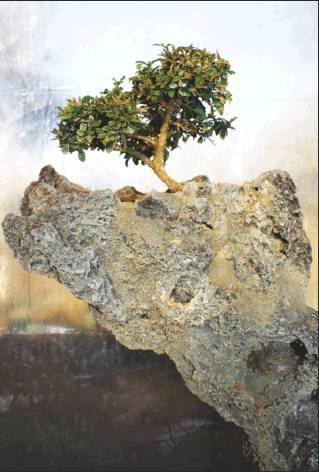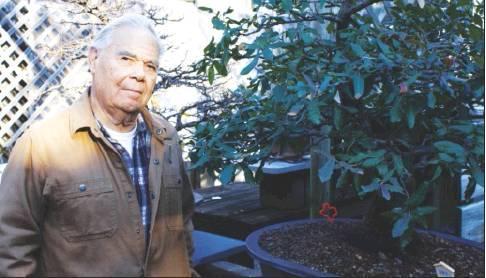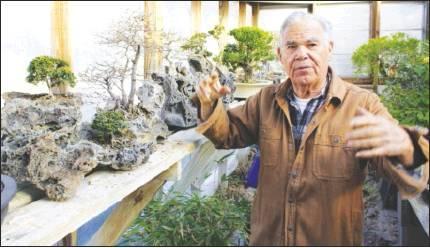Bonsai trees: A living form of art for decades in Wimberley
As the saying goes: “The bonsai tree symbolizes some of the keys to a lasting marriage and life: nurturing, patience, caring and growth.”
To Chuck Ware, the bonsai tree is a living art form. Ware should know. He owns hundreds of bonsai trees — of all shapes and sizes and species— and has hundreds more in training. Ware operates Jade Gardens and the Central Texas Bonsai Exhibit at 12404 RR 12. He’s lived there with his wife Pat for 50 years. For the last 30 years, Ware has raised bonsai trees, sold bonsai trees and worked to educate the public on the ancient practice.
When you talk to Ware the first thing you have to get straight is how bonsai is pronounced. Banzai is a suicide attack. Bonsai (pronounced bone-sigh) means “planted in a container” and is the art of creating or sculpting a small tree. The trees are not genetically dwarfed, almost any tree can be transformed into a bonsai.
At his bonsai exhibit, Ware has been working on some of his trees for decades. He makes it clear his exhibit is not a farm. “Farm gives the connotation of mass production,” he says. “We’re not growing cabbages here.”
He also makes it clear the bonsai is a form of art, akin to painting or sculpting. The only difference is the medium he works in is a living thing. “As you take any art form, it’s going to change as the environment changes. It went from China to Japan. Now it is all over the world.”
A brief history
Most people associate the bonsai tree with Japan, but the practice actually started in China, then spread to Korea and, in the 12th Century, to Japan. Buddhist monks, who wanted to bring the beauty of nature inside their temples, spread the art of bonsai. Many scholars think the practice dates back to 500 or 1,000 BC.
The little trees grew in popularity in the United States and Europe after World War II. Today, many countries produce bonsai trees, but Japanese trees are generally considered the highest quality.
Ware got interested in bonsai trees while he was teaching seventh and eighth graders in Wimberley. During his spring botany lessons he would bring in trees as teaching aids. When the lesson was over, he’d bring the trees back home and trim them down so he could use them again the following year. He emphasized trees from the Hill Country. Gradually, he became more and more interested in bonsai trees.
Now he is the owner of hundreds of trees that range in price from $30 to thousands of dollars.
“In bonsai, you focus on the look of the tree. But, like all art forms, before you know it you are into science and math,” he says. “There’s the physics of the soil, the chemistry of the fertilizer, the botany of the tree.”
For the most part, Ware is self educated. He has taken classes, talked to people and picked up information and techniques over the years.
“You have to learn what the needs of the individual trees are,” he says. “What kind of tree is it? Is it an inside or outside tree? Does it like the sun or shade? How much water does it need? There are many factors that go into growing a bonsai tree.”
A popular stop
As you drive along 12 one of the last things you’d expect to see is a bonsai exhibit, but, on a good weekend, 50-60 cars will pull in. There’s no charge to take a peaceful stroll among the trees. There are many miniaturized local species on display: elms, hackberries, live oaks. There are also more exotic trees such as the Brazilian rain tree and the pixie bougainvillea. Ware has babied and nurtured each tree he sells. He has matched it to its container. The trees are planted in ceramic pots or in rocks to create the desired harmony.
Ware has worked with some of his trees for 25 years. But everything in his exhibit is for sale. “I like to sell my trees to someone who wants them,” he says.
Ware lovingly trims the trees to get the shapes he wants. He digs the tree up to manicure the roots and put in new soil. There’s no timetable, he says, because each tree is different. Some are fast growers; others take their time. “I have to prepare the roots to go into the container,” Ware explains. “It isn’t just sculpting the top. It’s about complete balance.”
There are no guarantees with Ware’s bonsai trees. He has seen people over-water them, under-water them, give them too much sun or too much shade. In Japan, bonsai lovers are known to take the trees back to a nursery for a tune-up. That’s rare in the US. Ware tells the story of a customer who bought an expensive tree to be an outdoor focal point at a party. When asked about care after the party, the customer brushed it off and said the gardener would take care of it. Probably, that tree is not around today.
Ware equates raising a bonsai with raising a child: “It’s a long, slow process. Every tree is different, like every child is different. The object is to bring out the strength of the tree and cover up the flaws. Just like raising a child.”
He says if you follow a few simple instructions, the likelihood of a tree surviving are “pretty damn good.” The biggest problem, he says, is that people “don’t understand the needs of the tree.”
Ware understands the needs of his trees. Each one holds a special place. “I have been working on some of these trees for 25 years,” he says. “They have changed along with me.”




